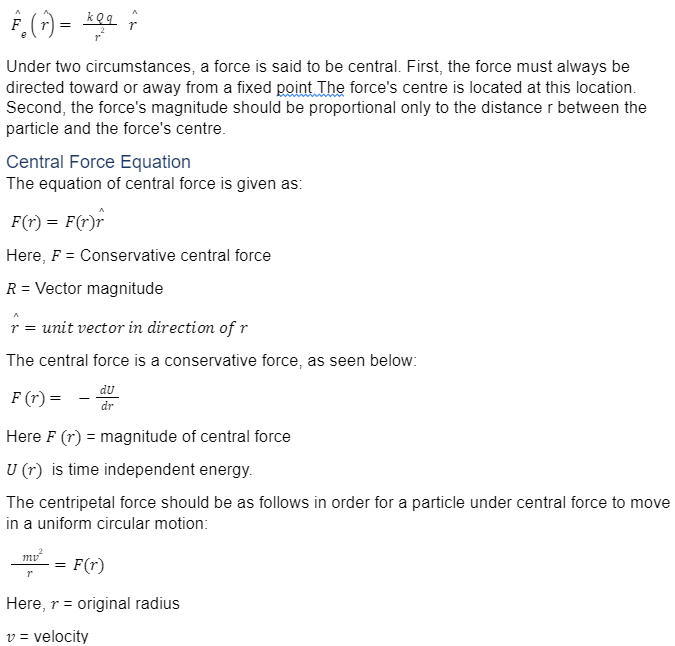The central force is a radial force whose magnitude is proportional to the distance from the source. The gravitational force, electrostatic force, and spring force are examples of core forces. In classical mechanics, the central force is defined as the force exerted on an object that concentrates along the line between the object and the origin. The ideas that link central force to angular momentum are as follows:
Theory 1: The object should only be treated to the central force in order to preserve its angular momentum.
Theory 2: An object should only be subjected to a central force if it wants to move in a plane.
Central force
A central force is a force that points in the (positive or negative) radial direction r and whose magnitude is solely determined by the distance r from the origin Fr=FrrThe three-dimensional idea of the radial distance (to the origin) and direction (direction of increasing r) is fully comparable to the two-dimensional case. The (generic) Newtonian gravity and the Coulomb force) between two charged objects are two notable examples of central forces.
The electric force is a nice example of a central force that you may already be familiar with: if I place a charge Q at the origin, the force on a second charge q sitting at point is r:

The primary force in physics is defined by a variety of natural occurrences. Here are a few examples: The sun revolves around the planets.
Natural satellites that fly around the globe.
In terms of speed against each other of two charged particles.
Motions in Central Force
Bounded motion: The gap between adjacent bodies or objects has a similar value in this motion and never exceeds the established values. The motion of the planets around the sun is an example of this type of movement.
Unbounded motion: The gap between two bodies or objects is infinity in the initial and final stages of this motion. The dispersion of alpha particles in the Rutherford experiment is an example of this type of movement.
Explanation of central force
When the force between two bodies is directed along the line connecting the two bodies’ centres of mass, it is called central force. Researching central force motion is crucial in physics since most of the physical forces we learn about are of this type, including gravitational, electrostatic, and some nuclear forces.
The central force is the force that acts along the line connecting the centres of two interacting entities. The direction of a central force is always away from a fixed point and towards the centre. In classical mechanics, the central force is defined as the force applied to an object that concentrates along the line between the object and the origin. The size of the central force is defined exclusively by the distance between the object and the centre.
Such systems include planets and comets orbiting a star, satellites orbiting a planet, binary stars, and classical scattering of atoms or subatomic particles. Although quantum mechanics is required for a thorough understanding of atoms and subatomic particles, a classical study of core forces can yield a wealth of knowledge even in this case.
Examples of Central forces
Planets orbiting the sun, natural satellites revolving around the earth, two charged particles moving against each other, Gravitational Force and Projectile Motion, Electrostatic, Magnetostatic Forces, and Simple Harmonic Motion are all examples of natural events that define the central force in physics.
Conclusion
The central force is a radial force whose magnitude is proportional to the distance from the source. A central force is a force that points in the (positive or negative) radial direction r and whose magnitude is solely determined by the distance r from the origin Fr=Frr. Bounded motion: The gap between adjacent bodies or objects has a similar value in this motion and never exceeds the established values. The motion of the planets around the sun is an example of this type of movement. Unbounded motion: The gap between two bodies or objects is infinity in the initial and final stages of this motion. The dispersion of alpha particles in the Rutherford experiment is an example of this type of movement. The central force is the force that acts along the line connecting the centres of two interacting entities.
 Profile
Profile Settings
Settings Refer your friends
Refer your friends Sign out
Sign out






